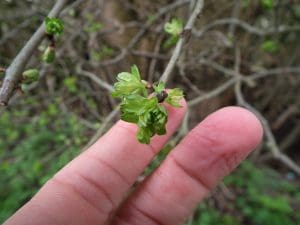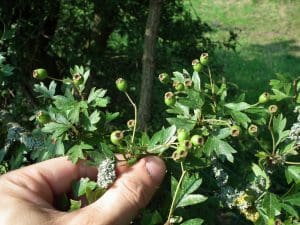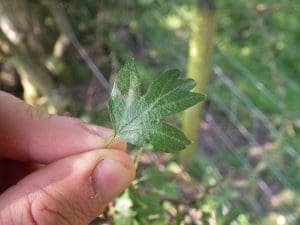Hawthorn / Spring / Summer / Autumn / Edible
Hawthorn is one of those plants that often blurs the line between medicine and food, it’s used for helping to regulate the heart and blood pressure, both for high and low blood pressure, but it can also be used in many recipes from Bakewell tarts to salads and even ketchup.
Common Names
Hawthorn, quickthorn, thornapple, May-tree, whitethorn, Mayflower, hawberry, Hawthorne
Botanical Name
Crataegus monogyna
Scientific Classification
Kingdom – Plantae
Order –Rosales
Family – Rosaeae
Physical Characteristics for Hawthorn
This large shrub or small tree can grow from 5-14m tall and grows an extremely dense crown. Its bark ranges from mid-dark brown and typically contains upward running orange cracks. The tree itself tends to grow twisted and contorted, making it look mythical, and the young branches contain many thorns.
Leaves
The leaves are dark green on top and light green underneath, they can grow from 2-5cms in length, are obvate or teardrop-shaped, and deeply lobed.
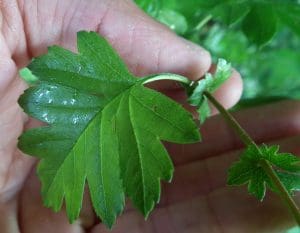
Flowers
The flowers, which are produced around May, have both female and male reproducing parts, they can be found in corymbs of 10-25 together. Each Flower is about 1cm in diameter and contains 5 white petals and are slightly fragrant.
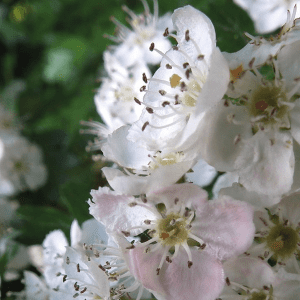
Fruits
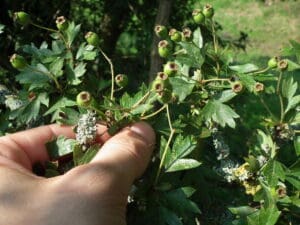
In autumn where there once stood flowers, you will now find haws. These are the trees fruit that resembles 1cm round red berries, although it is actually the structure of a pome, containing a single seed. Midland Hawthorn has two seeds, but looks identical in pretty much every other way. These two also hybridise readily, but it doesn’t matter which one you use because they are both equally edible.
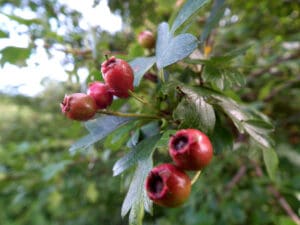 The fruits have a 5 pointed star shape on the bottom, like a tiny apple. Checking for this will help you avoid accidentally picking other, poisonous red berries!
The fruits have a 5 pointed star shape on the bottom, like a tiny apple. Checking for this will help you avoid accidentally picking other, poisonous red berries!
Habitat
It grows well in northern Europe, over the majority of America but mainly in the north and also Asia.
Hawthorn is native to the UK and has been historically used in hedgerows around farmers’ fields, although this is less common in Scotland. It will grow on acid and most other soils, heaths, rocky and open areas. It can be found in scrubs, thickets, woodland, and open areas although we mainly find it on growing mainly on moist soil.
Known Hazards
As its’ name implies Hawthorn contains many thorns up its branches which can give a good prick. If you’re on blood-thinning medication are not advised to eat lots of this plant, consult your doctor for this.
Could be confused with
This tree could quite easily be confused with the Blackthorn (Prunus Spinosa) or the Sloe bearing tree which does look quite similar. The easiest way to differentiate between these two plants is in spring; as the Hawthorn goes into leaf before flower, the Blackthorn will go into flower before leaf. Black and White bryony are climbing plants that often scramble over Hawthorn – although the leaves and berries look quite different, we have known inexperienced people to get them confused. When picking red berries, always check which stem it is attached to and whether it has that crucial 5-pointed star on the bottom – both bryonys have a dot on the berry instead of a star.
Our Hawthorn Foraging Video
Edible Use
The leaves: are edible when fresh and young, and are great in in salads and pasta dishes. In the past the young leaves and shoots were known as ‘Bread annd cheese’
The flowers have a lovely almond like flavour and are lovely in teas, syrups, cakes and deserts.
The fruits can be eaten cooked or raw and make excellent ketchups, chutneys, fruit leathers, are use them as an alternative to tomato puree.
Here’s a link to some of our favourite recipes using Hawthorn.
Notes on Herbal uses
Linking to the folklore of hawthorn being an extremely protective plant, it’s used in herbal medicine to help heart ailments, The chemical proanthocyanidin found within leaf, flower and the fruit of hawthorn can lower blood pressure.
Extra notes from the Foragers
Hawthorn wood is an extremely hard wood and works really well for carving, turning, and working with, it gives a pale finish and cuts very well.
If you have enough time and patience you can tap and collect the sap from the hawthorn during spring, as you would with pine, this can then be used instead of gum Arabic in the production of wild watercolours, although it shrinks a lot more than gum Arabic when drying, and this should be kept in mind.




